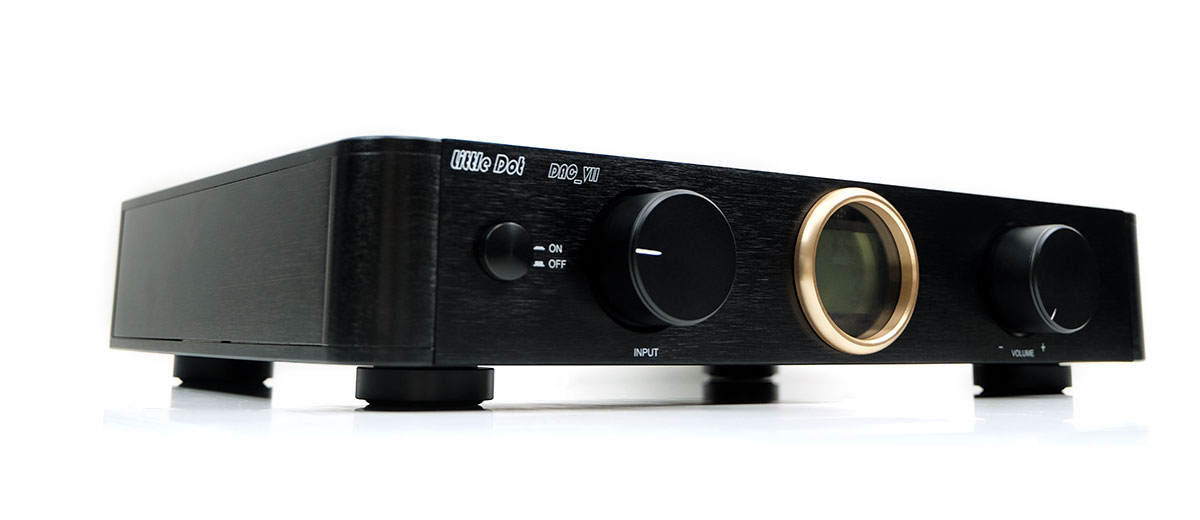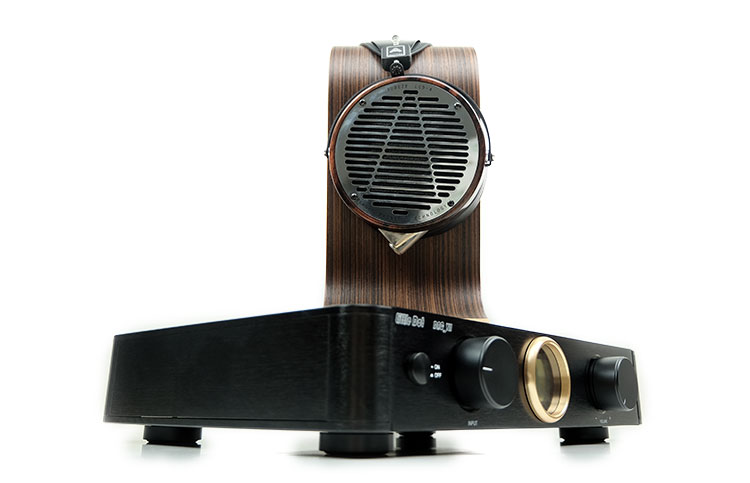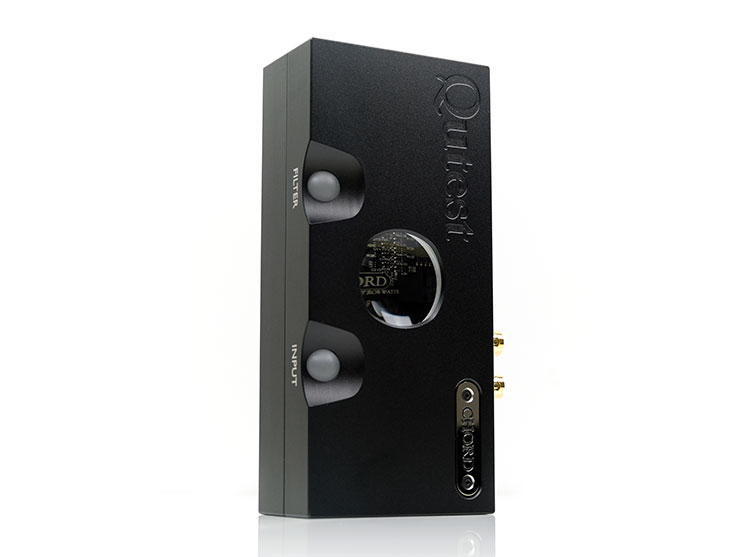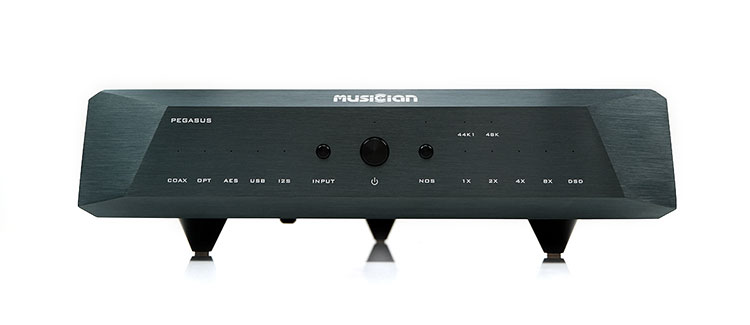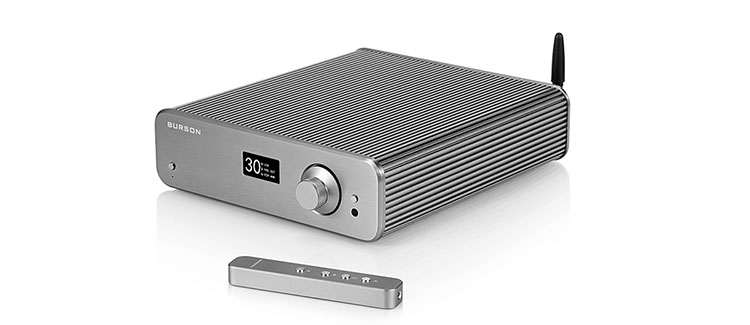Synergy
S/PDIF
There are some nuanced differences between the DAC VII’s USB, coaxial and optical performances. Testing with the Xi Audio Formula S I feel out of the three the USB connection offered the best dynamic range and resolution. Also, the timing felt a bit snappier with upbeat mixes and a slightly faster transient response on the low-end.
The optical connection had a marginal reduction in dynamic range with more upper-bass bloom into the mids creating a slightly softer sound to the lower pitching instrumental timbre. Staging just came in a little for me on the upper-mids with what seems a more aggressive treble fade but it is very minute. Overall, a bit more bloom and a more rounded tone.
The Coaxial performance was flatter sounding than the optical with a tighter bass response and better layering as well as instrumental separation. The timbre was cooler on the Formula S but it did offer more balance through the range. Possibly cooler than the USB performance whose treble felt the smoother of the two and with a more pleasing harmonic balance.
Pairings
Filling out
This is a great DAC if you want to ‘fill out’ a headphone’s low-end performance or introduce a stronger sense of PRaT into your amplifier’s performance. You can hook up most neutral or balanced analog amplifiers with excellent dynamic range and get an immediate taste of that improved low-end physicality and excellent sub-bass extension.
For example, the Auris Audio HA-2SF, which we recently reviewed has a nice punchy performance for a SET combined with a spacious staging quality. The DAC VII really makes wonderful use of both the space and the amps propensity to reach down low when required.
With competing DACs such as the Pegasus R2R this a balanced analog sound, rich in vocal texture and what you expect from a tube amp. However, with the DAC VII, it is more menacing, more physical, and more powerful sounding.
Any headphone that can respond to that or reference the difference is going to benefit from the DAC VII’s beefier tuning such as the LCD-4, the Ether 2, and even the D8000 Pro. They all pick up on the enhanced sub-bass growl and the vivid vocal presence quite easily.
Beefing up
The DAC VII can also do a great job beefing up a slightly lighter-sounding headphone amplifier. For example, the Xi Audio’s flagship Formula S is airy, sweet, and very articulate so I tend not to pair this with the likes of the neutral DACs. I am after something a bit more natural sounding with this amplifier.
My normal go-to is a pre-out via the dCS Bartok because of its excellent low-end reach of the Ring DAC. However, that is a wildly expensive setup which is where the DAC VII comes in. The DACs low-end coloration does inject a beefier and stronger sub-bass presence into the Formula S in a similar manner though not quite as gritty or warm as the Bartok.
What I like also about this combo is how well the Formula S retains that sweetness and articulation in the mids and treble. The DAC VII is energetic but not as bright as the Qutest for treble so the Formula S does well to retain its signature airy top-end sound.
You really want to pair a headphone that is spacious and deep sounding here such as the HEDD Audio HEDDphone to take full advantage of this combo’s impressive staging and power.
Select Comparisons
Chord Qutest
£1195
Technical
The Qutest was our Top Gear award-winning DAC from 2018 and a hugely different proposition to the DAC VII. Inside the Qutest is a proprietary DAC design based on Chord’s in-house FPGA Xilinx Artix 7 implementation rather than any delta-sigma or transistor rail design.
FIR filtering is then optimized for the precise timing of transients via Watts Transient Aligned filters (WTA) tap-lengths of which the Qutest is measured at 49,152 using a 10 element Pulse Array design which is the same as the Hugo 2. From there the converted analog signal is managed via a discreet design, (Class A), using the likes of flip flops, resistors, and capacitors.
The DAC VII, on the other hand, a more traditional delta-sigma DAC solution albeit using the Sabre flagship 8-channel ES9038PRO. Despite their different architecture, both decode up to DSD512 and PCM 32BIT/768kHz, neither offer MQA decoding or any wireless connectivity.
Connectivity on the rear is a little different also with the Qutest only offering a single dual RCA SE analog out whereas the DAC VII offers both SE and 3-pin balanced XLR outputs. The two DACs offer USB, coaxial, and optical digital inputs but diverge with the DAC VII offering I²S over RJ45 and the Qutest offering dual BNC input, (single is also useable).
Design
The two design philosophies of these DACs are quite a contrast. The Qutest is relatively tiny, compact, with a transportable form factor but very solidly built. The DAC VII is also very solid but much heavier, bigger, and very much a traditional desktop form factor.
One is powered by a simpler 5V DC external power supply, (Qutest), whilst the other has what seems to be a built-in SMPS or internal toroidal linear PSU and external power cable.
The DAC VII is a more straightforward control system with an LCD display for an accurate reading and somewhat functional remote control support. The Qutest instead goes for a more complex org color light system that also takes a bit of getting used to and not always instantly intuitive.
Both use filters with the Qutest’s 4 filters perhaps having more of an effect on the final output than the DAC VII’s 7 digital FIR choices. The one big difference is preamping. The Qutest only offers a single SE to the rear on a 1V, 2V, and 3V fixed voltage setting. The DAC VII can offer both SE and balanced output on 2V and 4V settings with volume control.
Performance
Between these two the Qutest is the cleaner or more neutral-sounding DACs when paired with the Auris Audio HA-2SF and using a Final D8000 Pro and LCD-4 setup. The DAC VII differentiates itself with its low-end power sounding the more physical of the two and slightly thicker up into the mids also.
The Qutest does extend a bit higher than the DAC VII with a particularly expressive treble and excellent top-end articulation. Here the DAC VII just slightly pulls back but not enough to sound rolled off. Rather it fades gently pulling the listener’s focus more to the mids and low-end solidity. Of the two, the DAC VII is probably the warmer or more natural sounding.
The Qutest delivers a lighter instrumental body, so it is not as rich or as broad sounding as the DAC VII. It is punchy though, perhaps offering better energy and instrumental separation but it does not deliver the same impressive fundamental as the DAC VII. The Little Dot pairing is incredible for EDM, R’n’B, or anything that needs a bit of meat on the bone.
The mids pretty much follow the same pattern with the DAC VII having a little more intimacy and a stronger vocal presence with a fuller tone. The Qutest focuses instead on delivering an articulate, complex midrange but also a neutral staging position with more of a high-fidelity lighter note body and heavier on odd-harmonics.
Musician Audio Pegasus
$1099
Technical
The Pegasus introduces another completely different approach to decoding implementation in a DAC called R2R or a resistor ladder network, (R/2R).
Inside you have discrete balanced 24BIT ladder rail implementation for core R2R native 1BIT PCM decoding and then a separate ladder for decoding DSD (6BIT). Behind that, you have an Altera Cyclone IV FPGA implementation combined with a FEMTO Crystal oscillation for DSP and jitter control.
The DAC VII uses a single chip delta-sigma ES9038PRO solution which negates the need for a resistor to resistor decoding system. It is faster to implement, perhaps more reliable to a certain degree given transistors over time are prone to slew but also more limiting in terms of certain parameters such as I/V.
The Pegasus does have an edge for topline decoding at 32BIT 1536kHz for PCM and up to DSD1024 compatibility via I2S and USB whereas with the ASIO driver, the DAC VII can decode up to 32BIT/768kHz and DSD512. Neither do MQA nor handle any wireless connectivity but both do require ASIO drivers for Windows full functionality.
I/O is much the same on both units aside from AES how they handle I²S. That means balanced XLR and SE RCA analog outputs, and coaxial, optical, and USB digital inputs. The DAC VII is missing an additional AES connection offer by the Pegasus as well as I²S via RJ45 ethernet whereas the Pegasus is via HDMI.
The output rating of both SE and balanced on paper is a little bit stronger on the Pegasus at 2.2V and 4.4V compared to the DAC VII’s 2V and 4V. However, in our real-world resting in the Pegasus review, we felt that the Pegasus output impedance at 625Ω SE and 1250Ω balanced a bit high and thus slightly attenuated for volume.
Design
Both DACs are squarely in the desktop category and very solid in the build quality department. However, the DAC VII is the bigger of the two in terms of dimensions and the heavier also. Nothing official from Little Dot in terms of weight but much heavier than the 3.9Kg of the Pegasus.
The design flow of the Pegasus is more modern also with a sleep gunmetal design and trapezoid styling of the front panel. The DAC VII has a more traditional shape with an Asian gold accent, (LCD frame) on an all-black aesthetic.
The Pegasus lacks an LCD display and remote control, however. Some might prefer the DAC VII LCD readout which allows you to see the input and sample rate. The DAC VII also has a preamp which the Pegasus lacks so you have the additional volume control whereas the Pegasus is a fixed voltage setup.
What the Pegasus does have is NOS or non-oversampling allowing you two types of sound signatures whereas the DAC VII allows you to pick the ES9038PRO filter suite. Both are nuanced but NOS is easier to pick out in terms of top-end treble presence changes making it a more flexible tweak.
Performance
R2R traits really make the difference here though if you are after quantity on the low-end then the DAC VII has the edge. Where the Pegasus has the edge is if you are looking for a balanced sound signature with more of an analog-sounding timbre.
Only once you compare the DAC VII with the Pegasus do you have any inkling that the Little Dot unit is a delta-sigma Sabre chipset. It is cleaner, tighter on transients, and also with better separation compared to the Pegasus. However, it lacks a little in comparative textural detail, particularly in the mids and treble where the Pegasus less polished, less perfect, and more life-like.
On the low-end, the DAC VII does have the better sub-bass extension and a palpable sense of power that the Pegasus cannot really outmaneuver. The DAC VII bass sounds urgent, punchier, and more physical. The Pegasus low-end is a little softer, more liquid in tone, and with a longer decay on the HA-2SF with both the D8000 Pro and LCD-4.
The mids resonate a bit better for me on the Pegasus simply due to that beautifully textured and analog timbre in instruments and vocals. The DAC VII does very well avoiding the hallmarks of a Sabre DAC but still sounds a little digital in comparison.
Vocal imaging is more forward though on the DAC VII so it can sound more intimate or immediate. Combined with the stronger PRAT and slightly more spacious sound the DAC VII will come across as the more vivid high contrast sounding DAC.
The Pegasus is more forgiving but also the DAC of choice for those who love a vocal and instrumental timbre with a bit more nuanced detail and character.
Burson Audio Composer 3X Performance
$1144
Technical
Inside both use an ES9038 DAC chipset though the VII uses a PRO version as opposed to the Composer 3X Performance’s 2-channel Q2M variant. Opamps inside the VII are not rollable and I have to presume the I/V or L/P are not bypassed in the same manner as the Composer 3X Performance topology.
The decoding potential, however, is as good as the Burson with up to DSD512 native, (Amanero Combo384 Module), and PCM 32BIT/768kHz decoding capability.
Neither are MQA compatible and the Little Dot DAC VII has no Bluetooth streaming capability but its ethernet input tap into LAN networks and accept portable WiFi hubs for lossless streaming.
On the performance side, both have pre-amp variable voltage and volume control suitable for power amp connectivity. The Vrms is the same at 2V unbalanced and 4V balanced via a rear set of RCA and 3-pin XLR. I cannot give you an exact like for like labeling or even if the DAC VII is a weighted measurement but the dynamic range is impressive at 132dB.
Connectivity
Both DACs can output an analog signal in balanced and unbalanced and both have USB, coaxial and optical connectivity. The DAC VII uses a traditional USB-B port as opposed to USB-C on the Burson.
The DAC VII does have an additional ‘I²S labeled port’ but it is not a typical HDMI pin slot but rather an ethernet-type RJ45 connection. That means you need a crossed CAT5 cable rather than a regular 1-1 CAT 5 or an RJ46 to HDMI adapter cable.
Design
The DAC VII is a big traditional almost mechanical sounding pure black desktop DAC. It is much bigger and heavier than the compact Composer 3X Performance.
You could argue the DAC VII design is grandiose, high-end in a way but also old-school HiFi in another way. The Composer 3X Performance is also a very sturdy little DAC design but a lot simpler in looks.
One thing to note is the volume control on the DAC VII is not a limited mechanical dial from left to right. You can technically swing it 360 without ever hitting any physical stop so be careful with your volume settings (LCD display) when in pre-out mode.
Both do have remote controls but the Burson remote design is tastier with a full aluminum chassis and clear labeling for functionality. The DAC VII remote is an odd white plastic creation with minimal labeling.
V6 Vivid Performance
With the stock V6 Vivid opamps, the Composer 3X Performance is the more neutral of the two DAC’s through to the mids but with a slightly more treble energy and presence. Honestly, I was not surprised given the propensity of the Vivid opamps to sound lively up top.
The DAC VII low-end density and sub-bass extension on the HA-2SE has more warmth and quantity and this does ‘shine through’ on the HA-2SE/Ananda pairing very easily.
As a result, the DAC VII sounds the more rounded of the two for timbre. It has more low-end warmth and power with slightly less treble meaning the mids take on more of a liquid and richer texture to instrumental and vocal notes.
It can seem more intimate as a result because of the solidity and forwardness of the bass response but in actuality I found the imaging to be very good in terms of depth and width.
What I did find was the V6 Vivid performance to offer a bit more headroom and a livelier percussion timbre. This is a cleaner sound, perhaps not as much depth as the VII comparatively speaking but it has this fast, articulate feel with excellent separation.
V6 Classic Performance
The V6 Classic dual opamps do not really tip the balance in terms of a timbre match with the DAC VII, especially on the low-end. The DAC VII was already heavier and denser on the low-end compared to the punchier Vivid opamps so it is even more emphasized now given the V6’s more neutral bass quantity.
What has changed is the mids and treble timbre to be a little less transistor type with the Classics and offer a smoother sound. It still has more treble energy but marginally wetter and with a more prominent midrange presence.
As a result, imaging is a bit further forward for vocals still but the DAC VII still delivers the perception of a bit more chest, bit more low-end roundness adding a lot of texture and weight to breathy vocals. The Composer 3X Performance vocal timbre is sweeter and lighter with more of a mixed voice tone to those same vocals, especially falsetto.
Our Verdict
I had no clue what to expect with the Little Dot DAC VII. Sure, it’s the company’s TOTL DAC so I got some excellent resolution and I expected that but the big surprise was the power and dynamic range from that ES9038PRO implementation.
This DAC has bags of energy, body, and excellent PRaT with our tested amps. Vocals are also to the fore, vivid and firm sounding. Nothing neutral, too clean, or sterile sounding so pick the right amp and this DAC will do a great job filling out a headphone with excellent bass potential.
Caveats? The control system is a bit weak, archaic in a way with a remote control that is just too cheap and not well implemented. And, whilst ethernet connections could possibly deliver a better sound over USB an alternate HDMI socket would be ideal or perhaps a wireless option. There does seem to be space for it along with BNC which would be the icing on the cake.
Otherwise, an excellent ruggedly built DAC with a very surprising sound signature at a very competitive price I must say.
Little Dot DAC VII Specifications
- Supported formats: 44.1/48/88.4/96/176.4/192/352.8/384/768KHz 16/32-bit
- DSD64, DSD128, DSD256, DSD512 (2.8224-22.5792 MHz)
- Input mode: USB, TOS, COAX, IIS
- Output level: XLR: 4V RMS RCA: 2V RMS
- Decoding frequency response: 20Hz ~ 20KHz +/- 0.2 dB
- Decoding dynamic range: DNR 132dB
- Decode harmonic distortion: THD -120dB
- Power consumption of the machine: 25 VA

